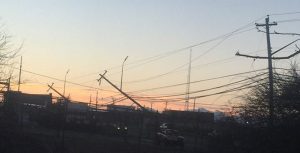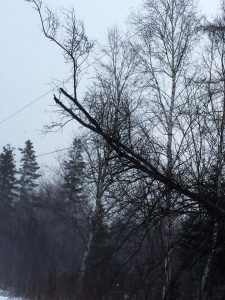We have now had the first power outage of 2018, and I hope you made it through alright. I hope you weren’t one of the many whose power was out for over two days.
Thank you to the linemen, from both NS Power and from the other companies that were brought in. You did a great job in restoring the power. You shouldn’t have had to do as much work as you did, but years of bad planning have brought it along.
The is the first post of a number of posts that talks about the issue, and discusses some ideas to correct it.
Nova Scotia Power is (no pun intended) a very powerful private organization. Virtually every Nova Scotian relies on it, and virtually every family and business pay money to it. With that kind of responsibility, they are surely doing their best to make sure that we all get our power — that the infrastructure is solid. At least … we hope that they are.
Storms are a fact of life. With the climate changes that we’ve seen, we can expect more large storms. We need to be prepared for them.
There are some decisions that seem to have been made, over the years, that made things worse. We need to look at those decisions.
Many power poles snapped
 The wooden power poles are treated so that they become stronger and more durable. Over the years, this treatment washes out, and they lose their strength. The maximum life of these poles is about 70 years, if we’re lucky.
The wooden power poles are treated so that they become stronger and more durable. Over the years, this treatment washes out, and they lose their strength. The maximum life of these poles is about 70 years, if we’re lucky.
Nova Scotia Power has talked about burying lines underground. They have stated that it costs three times as much to bury lines as it does to have them on power poles. That number seems low to me, but others have determined that it is accurate. Regardless, we need to review this again.
Other jurisdictions have started switching to composite poles. You can find out more information about composite poles here. Composite poles promise a longer life, a heavier load, and a lower cost than the wooden poles that we are currently using. If we are not going to bury our lines then we should at least switch to poles that will last longer.
Trees fell on lines
 One of the great things about Nova Scotia is the number of trees that we have. One of the big problems with Nova Scotia Power is that we have a lot of trees.
One of the great things about Nova Scotia is the number of trees that we have. One of the big problems with Nova Scotia Power is that we have a lot of trees.
Sometimes the trees are huge, and we love that. Sometimes the storms will knock the trees down and, unless the power lines are buried, the trees will take out the power lines.
Other times the trees are still small and grow through the power lines. When they grow too big, or if there is a storm, they will hit the power lines and will cause an outage. This happened to me over the past summer.
Some number of years ago, Nova Scotia Power stopped trimming the trees that grow too close to power lines. This decision has saved them (management) a lot of money in maintenance, but it has cost us (customers) a lot of money to get the trees cut down. Since there are live power lines running through the trees this isn’t something that we can do on our own. We need professionals, with the right equipment, and so Nova Scotia Power has successfully deflected a cost out of their books and back in to our pockets.
“Salt fog” and “Salt contamination”
We love that our province is surrounded by the ocean. That brings a lot of salt water with it.
Through the years, Nova Scotia Power has blamed power outages on the salt. Years ago it was salt fog. With this outage it was salt contamination. These explanations are ridiculous. The salt is not new. When we buy our cars, we know that they will have to be checked and protected, or else the salt will chew them apart after a few years.
Nova Scotia Power needs to consider our environment with every single purchase and with all of their maintenance plans. The equipment that they install has to withstand ocean spray, if it’s near the ocean. It has to withstand the winds that we will be getting. It has to withstand the ice and cold. The inspection and maintenance plans have to be more vigilant and check for deterioration from the weather that we get.
Things need to change
We can not continue to have power outages based on an infrastructure that is falling apart. Nova Scotia Power has to do a better job of installing the right equipment; of maintaining the good equipment that is in place; and of replacing the equipment that will fail soon.
We pay too much money to that monopoly for the service that we are getting. Nova Scotia Power needs to do a better job for us, their customers.
Nova Scotia Power needs to be as responsive to us as their linemen were through this last storm.
